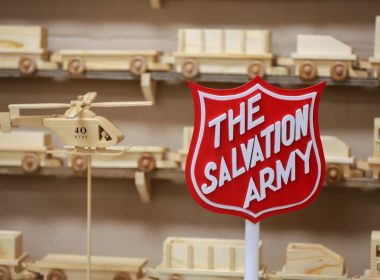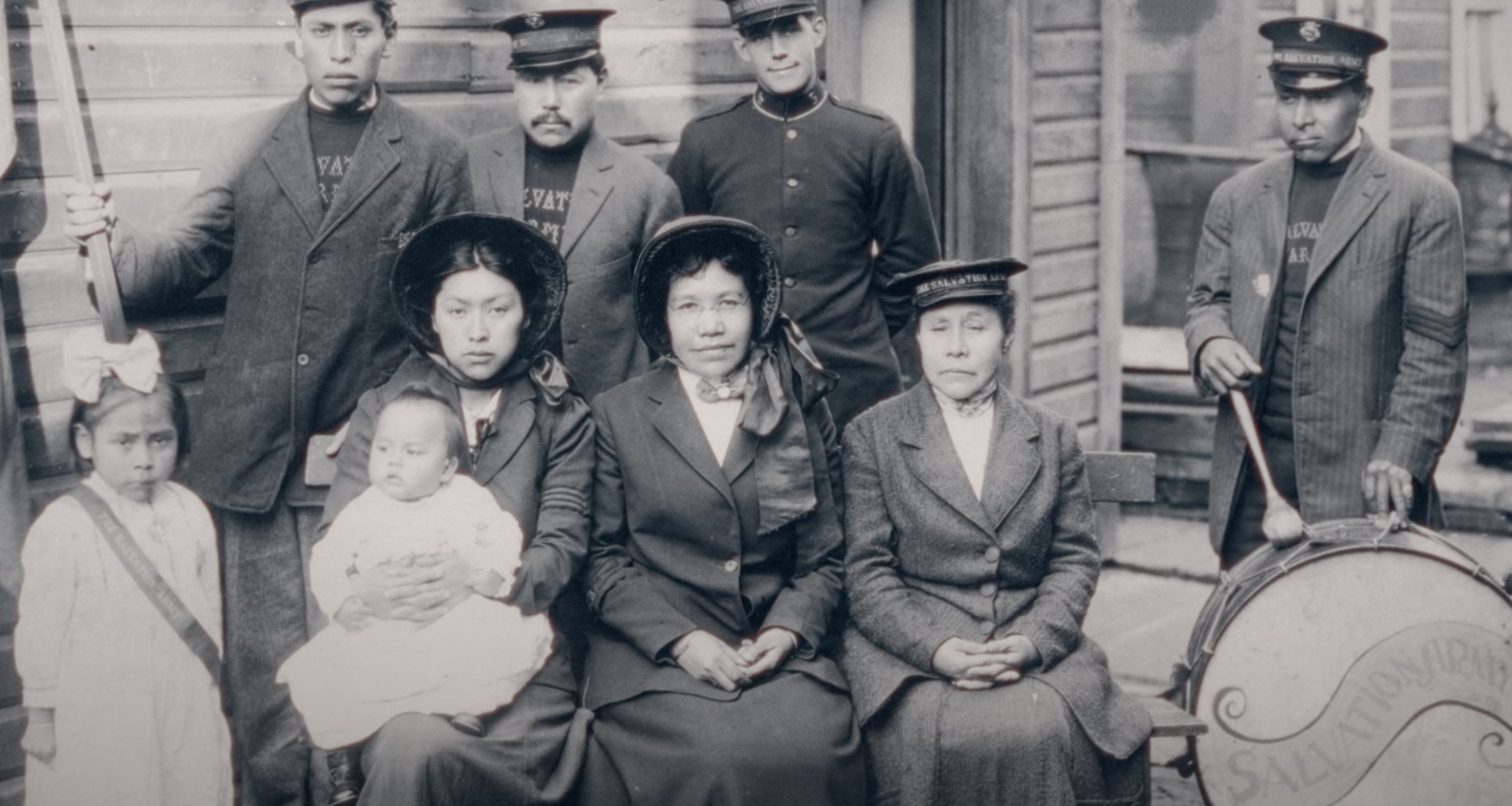It’s the mid-1800s in London, England. Poverty and overcrowding are at record highs. Society—and the church—have turned their backs on “those poor souls.”
Seeing the need, The Salvation Army is founded, to reach the least, the last, and the lost.
But they were greeted not with praise, but derision and harassment: By establishment churches for being too radical, and by pub owners and local politicians for being too priggish. It soon escalated to a decade’s worth of violent attacks against the Salvationists by an armed group calling themselves the Skeleton Army.
This is the story of the fire from which The Salvation Army’s ministry and social work emerged, and how the uniform they developed is a prime example of the trials in which they not only survived—but flourished.
Below is a transcript of the video edited for readability.
Major Jo Moir: The Salvation Army uniform has always been more than just an outfit that Salvationists wear. It’s always been something about wearing a promise. But it was met with some disdain.
Steven Spencer: There was opposition to The Salvation Army from local interests, and the scale of some of the opposition is enormous.
Captain Clint Trimmer: The uniform is our symbol, a symbol of compassion and love, and a symbol of Christ’s presence in the world.
Especially in the mid-19th Century, you have a lot of folks moving from the countryside into urban centers and you get a situation where you have too many people for the number of jobs.
Steven Spencer: The sanitation was very poor, disease was common. Working conditions were often horrific, unsafe, poorly paid. By the middle of the 19th Century, East London had become a synonym for this kind of urban poverty, a kind of social immorality, a moral laxity.
Captain Clint Trimmer: Darwinism is gaining increased popularity, as well as Social Darwinism, this idea that a class that is the financial foundation of the country is better fit for survival.
If you accept that as justification for your wealth, that also means that people who are poor are unfit. And so it gives a new justification to why people should be in certain places within society.
Now, at the same time that’s happening, you see the church kind of retreating. And so people are increasingly needing a church that goes outside its walls, but you have a church that’s increasingly retreating within its walls.
Steven Spencer: In response, The Salvation Army begins in the 1860s in the East End of London, and it really is very distinct from other religious denominations at the time.
There’s an appeal made to a kind of urban working class audience, to groups of people that were not seen to be being reached by the established churches.
And Salvation Army evolves a series of kind of methods and techniques and a sort of style that’s very different from what other churches look like. It’s going to be almost a literal invasion. They’re going to make a noise.
And people were encouraged to just start preaching in the street. Don’t wait till you’ve got an audience, just stand in a town square and start preaching.
Major Jo Moir: The Open Air meetings, they were about attracting people with the noise.
Steven Spencer: The Salvation Army is seen as quite a vulgar, working class thing.
Major Jo Moir: They were happy to be considered as disreputable. They were happy to be considered trouble causers.
Steven Spencer: Their tactics, their language and their quite, kind of anarchic style, was very different from what those people knew of religion.
Major Jo Moir: There was pushback, mostly from other churches.
Steven Spencer: The style, and the content, and the locations of preaching, is being attacked from kind of all sides, really.
The 1870s is a time where the British Army is really popular. There’s a lot of the Army in the culture.
Captain Clint Trimmer: War is seen in a much more positive light. And there’s this idea of, “We are at war with sin.” “We’re at war with the ills of society, we’re going to be at war against the things that cause oppression.”
And so as that terminology starts, and people start using ranks and flags, eventually we start seeing uniforms.
Steven Spencer: The uniform, while it emerges almost organically, it certainly almost immediately serves a whole range of actual useful purposes. It makes Salvation Army members identifiable to other people.
Captain Clint Trimmer: It becomes this symbol of membership, that I’m part of something bigger than myself.
Steven Spencer: They’re all wearing the same uniform in the same meetings, and it is an absolute leveler.
Major Jo Moir: Our uniform was just this equality, this simplicity, and this practicality all rolled into one.
Steven Spencer: But it’s also clear that this was seen as being a bit weird, the fact that people were dressed as soldiers, people wearing military uniforms, especially women wearing military uniforms.
Major Jo Moir: In the East End of London, women were very much subordinate. They would be valued by how well they had married, they would be valued by whose family they were connected to.
Steven Spencer: Certainly for women, being able to wear a uniform that identified you as being a Salvationist, gave women a kind of armor, and it could allow them to go into places where normal single women, or even groups of women, wouldn’t be allowed to go.
In slum areas, in parts of East London where there would be questions about a woman’s morality if she was seen by herself. It gave women a kind of authority, and it meant they could sort of slightly transcend the limits of Victorian expectations.
Captain Clint Trimmer: The [Salvation] Army had kind of ramped up their Open Airs, specifically in front of pubs. As you’re going in, you’re hearing these preachers talking about the detrimental effects of alcohol and alcoholism. The owners of these places started seeing their faithful clientele disappear.
Major Jo Moir: People were not going to the pub anymore to get drunk, they were not going and gambling, they were not getting involved in prostitution, they were literally turning their lives around, and the uniform marked them out as different.
Captain Clint Trimmer: You have groups like the Skeleton Army develop, which are basically bar toughs, that are paid by the bar owners to go out and disrupt those meetings.
Steven Spencer: Local people begin to violently attack Salvation Army. They have banners with some skeleton imagery on it. In some cases, it is also backed by local publicans, backed by local magistrates who are supporting these people who are violently attacking Salvationists.
You get Skeleton Armies eventually over the whole of the UK. And as the 1880s progress, this opposition becomes more fervent, becomes bigger. There’s a huge spectrum of violence against Salvationists. Officers are punched, stomped on, trampled. It’s right up to large scale mob violence.
Major Jo Moir: Which is one of the reasons the women wore bonnets, straw bonnets, because they could withstand the ammo that was coming their way, which was mostly rocks.
Steven Spencer: The scale of some of the opposition is enormous. Thousands of people, which is almost difficult to believe.
During this period of opposition, The Salvation Army expanded numerically. And as the social work expands, people, particularly in the establishment, began to see The Salvation Army actually has a positive force. It’s seen as being less of a threat.
The Salvation Army is harnessing forces which are on the ascendant historically, a sort of evangelical revival, the beginnings of a kind of social work.
Whereas the Skeleton Army is kind of the remnant of the power of local elites, those forces are on the descendant. A lot of the people behind the violence had come to realize that it wasn’t working, it was counterproductive.
Major Jo Moir: As The Salvation Army became more respectable and more understood, the uniform started to morph a little bit. And I think therein lies its value, is that it can be adaptable. Wherever you go, there is a different style of uniform that’s appropriate for that culture.
The future of The Salvation Army uniform is to keep being adaptable, keep being flexible with it, but keep wearing it because we’re wearing a promise.
Captain Clint Trimmer: The uniform still carries with it a lot of symbolism and it is connected with the ministry being done by those who wear the uniform. So as long as that ministry continues to be impactful in our communities and in people’s lives, I think the uniform will stay.
Do Good:
- See more videos like this in our video feed.












